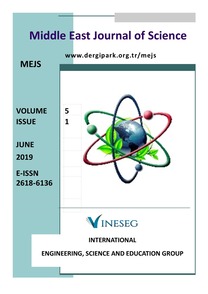BIOCHEMICAL INVESTIGATION OF THE PHARMACEUTICAL AND COSMETIC USE OF NARCISSUS (Narcissus tazetta L. subsp. tazetta L.) GROWING NATURALLY AROUND IN MUĞLA, TURKEY
___
[1] Willis, J., Amaryllidaceae. In: Shaw A, editor. A dictionary of the flowering plants & ferns. 8th ed. Cambridge Cambridge University Press; pp: 49-50, 1988.[2] Nair, J.J., Bastida, J., Codina, C., Viladomat, F., Van Stadene, J., “Alkaloids of the South African Amaryllidaceae: a Review”, Natural Product Communications, 8(9), 1335-1350, 2013.
[3] Tanrıverdi, F., Çiçek üretim tekniği, (Sera ve açık alanlarda saksı, kesme ve bahçe çiçeği yetiştirme ilkeleri ders kitabı, İnkilâp kitabevi, İstanbul, 1993.
[4] Baytop, T., Türkiye'de Bitkiler ile Tedavi, 2.baskı, 480 sayfa, Nobel Tıp Kitabevleri, İstanbul, (ilk baskı 1984), 1999.
[5] Bastida, J., Lavilla, R., Viladomat, F., Chemical and biological aspects of Narcissus alkaloids. In: Cordell, G.A. (Ed.), The Alkaloids, vol. 63. Elsevier, Chicago, pp: 87-179, 2006.
[6] Bastida, J., Berkov, S., Torras, L., Pigni, N.B., de Andrade, J.P., Martínez, V., Codina,C., Viladomat, F., Chemical and biological aspects of Amaryllidaceae alkaloids, In: Mu˜noz-Torrero, D. (Ed.), Recent Advances in Pharmaceutical Sciences. Transworld Research Network, Kerala, pp: 65-100, 2011.
[7] Jin, Z., “Amaryllidaceae and Sceletium alkaloids”, Natural Product Reports, 24, 886-905, 2007.
[8] Rezanka, T., Rezanka, P., Sigler, K., “Glycosides of benzodioxole-indole alkaloids from Narcissus having axial chirality”, Phytochemistry,71(2-3), 301-306, 2010.
[9] Pigni, N.B., Rios-Ruiz, S., Martinez-Frances, V., Nair,J.J., Viladomat, F., Codina, C et al., “Alkaloids from Narcissus serotinus”, Journal of Natural Product, 75(9), 1643-1647, 2012.
[10] Jin, Z., “Amaryllidaceae and sceletium alkaloids”, Natural Product Reports, 30(6), 849-868, 2013.
[11] Buckingham. J., Baggaley, K.H., Roberts, A. D., Szabo, L.F., Dictionary of alkaloids, USA: CRC Press Taylor & Francis Group, 2010.
[12] Harvey, A.L., “The Pharmacology of galanthamine and its analogs”, Pharmacology & Therapeutics, 68(1), 113-128, 1995.
[13] Weniger, B., Italiano, L., Beck, J.P., Bastida, J., Bergonon, S., Codina, C et. al., “Cytotoxic activity of Amaryllidaceae alkaloids”, Planta Medica, 61(1), 77-79, 1995.
[14] Triana-Vidal, L.E., Carvajal-Varona, S.M., “Protective effect of galantamine against oxidative damage using human lymphocytes: A novel in vitro model”, Archives of Medical Research, 44(2), 85-92, 2013.
[15] Feldman, H.H., Pirttila, T., Dartigues, J.F., Everitt, B., Van Baelen, B., Brashear, H.R et al., “Analyses of mortality risk in patients with dementia treated with galantamine”, Acta Neurologica Scandinavica,119(1), 22-31, 2009.
[16] Bradford, M.M., “A rapid and sensitive method for the quantitation of microgram quantities of protein utilizing the principle of protein-dye binding”, Analytical Biochemistry, 72(1-2), 248-254, 1976.
[17] Rawdkuen, S., Vanabun, A., Benjakul, S., “Recovery of proteases from the viscera of farmed giant catfish (Pangasianodon gigas) by three-phase partitioning”, Process Biochemistry, 47, 2566-2569, 2012.
[18] Fadıloğlu, S., “Immobilization and characterization of ficin”. Die Nahrung [Food], 45(2), 143-146, 2001.
[19] Gülçin, I., Alıcı, H. A., Cesur, M., “Determination of in vitro antioxidant and radical scavenging activities of propofol”, Chemical & Pharmaceutical Bulletin, 53(3), 281-285, 2005.
[20] Can, Z., Yildiz, O., Sahin, H., Turumtay, E.A., Silici, S., Kolayli, S., “An investigation of Turkish honeys: their physico-chemical properties, antioxidant capacities and phenolic profiles”, Food Chemistry, 180, 133-141, 2015.
[21] Lehninger, A.L., “Principles of biochemistry”, New York: Worth Pub-lishers Inc., 2013.
[22] Yapar, E.A., “Fitokozmetikler”, Türk Farmakope Dergisi, 3 (1), 110-116, 2018.
[23] Sova, M., “Antioxidant and antimicrobial activities of Cinnamic acid derivatives”, Mini-Reviews in Medicinal Chemistry, 12 (8), 749-767, 2012.
[24] Yrbas, M.A., Morucci, F., Alonso, R., Gorzalczany, S., “Pharmacological mechanism underlying the antinociceptive activity of vanillic acid”, Pharmacology Biochemistry and Behavior, 132, 88-95, 2015.
[25] Espíndola, K. M. M., Ferreira, R. G., Narvaez, L. E. M., Rosario, A. C. R. S., Silva, A. H. M., Silva, A. G. B., Vieira, A. P. O., Monteiro, M. C., “Chemical and Pharmacological Aspects of Caffeic Acid and Its Activity in Hepatocarcinoma”, Frontiers in Oncology, 21 June 2019 https://doi.org/10.3389/fonc.2019.00541. 2019.
[26] Srinivasulu, C., Ramgopal, M., Ramanjaneyulu, G., Anuradha, C. M., and Suresh, K. C., “Syringic acid (SA) ‒ A review of its occurrence, biosynthesis, pharmacological and industrial importance”, Biomedicine and Pharmacotherapy, https://doi.org/10.1016/j.biopha.2018.09.069, 2018.
[27] Zduńska, K., Dana, A., Kolodziejczak, A., Rotsztejn, H., “Antioxidant properties of ferulic acid and its possible application”, Skin Pharmacology and Physiology, 31, 332-336, 2018.
[28] Sun, M.Y., Ye, Y., Xiao, L., Rahman, K., Xia, W., Zhang, H., “Daidzein: A review of pharmacologıcal effects”, African Journal of Traditional, Complementary and Alternative Medicines, 13(3), 117-132, 2016.
[29] Lin, Y., Shi, R., Wang, X., Shen, H.M., “Luteolin, a flavonoid with potential for cancer prevention and therapy”, Current Cancer Drug Targets, 8(7), 634-646, 2008.
[30] Bae, J., Kim, N., Shin, Y., Kim, S.Y. and Kim, Y.J., “Activity of catechins and their applications”, Biomedical Dermatology, 4(8), 1-10, 2020.
[31] Shay, J., Elbaz, H.A., Lee, I., Zielske, S. P., Malek, M. H. and Hüttemann, M., “Molecular Mechanisms and Therapeutic Effects of (−)-Epicatechin and Other Polyphenols in Cancer”, Oxidative Medicine and Cellular Longevity, Article ID 181260, 1-13, 2015. doi.org/10.1155/2015/1812602015.
- ISSN: 2618-6136
- Yayın Aralığı: 2
- Başlangıç: 2015
- Yayıncı: -
Cansu BAŞARAN CANER, Sait ENGİNDENİZ, Zhansaya BOLOTOVA
Nazan DEMİR, Sıla Nezahat DAŞDEMİR, Alevcan KAPLAN
Nazan DEMIR, Sıla Nezahat DAŞDEMİR, Alevcan KAPLAN
Muharrem ERGUN, Zahide SÜSLÜOĞLU
DETECTION OF SOME VIRULANCE GENES AND VARIATION OF Acinetobacter Baumannii
Noor Hussein AHMAD, Ghada A. MOHAMMAD
DETECTION OF SOME VIRULENCE GENES AND GENETIC VARIATIONS OF ACINETOBACTER BAUMANNII
